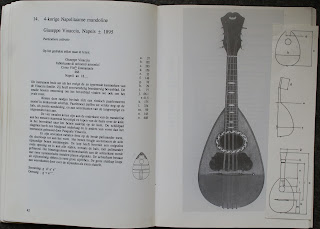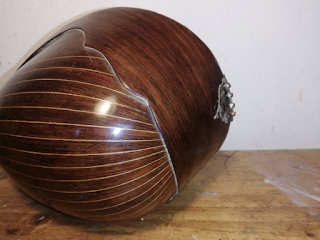Giuseppe Vinaccia
Giuseppe Vinaccia
This mandolin has no label nor any brandmarks but the sound,
the way it has been built and the trim alongside the soundboard
are quite convincing. The form of the scratchplate is identical to
an instrument that was put up for an auction at Bonhams.
In fact a more simple instrument but even these instruments
are worth their money. It has everything to do with refinement
of tone. Probably a Giuseppe Vinaccia mandolin as some
elements are pointing in that direction. Identical scratch plates,
the extra co bring alongside the soundhole, wood choice,
especially of the soundboard and inlay of the edges.
Judge for yourself with a genuine Guiseppe Vinaccia
put up for auction at Catawiki here beyond.
Twee Vinaccia mandolins where you can study the bowl.
And the typical "bulb" near the neck joint.
The way the neck has been attached to the body.
The sound hole can be studied here: The rings around
the sound hole as well as its' inner layer of wood in
the sound hole itself is quite convincing.
On the mandolin here above a bt mor simple endcap
has been mounted.
Most Vinaccia have a specific curve in the bowl,
resulting in a kind of bulb near the neck mounting.
One can conclude here that the head has been
repaired in the past. The tuners are alike but
they do on various mandolins as there were
extern suppliers of parts for most mandolin
makers.
A quite often used head form but very often found
on the Vinaccia family mandolins.
The inlay of the edges can be studied here as well
as the rings around the sound hole.
The "bulb" near the neck mounting can be looked at.
A hand signed label in this mandolin. As there were
befriended luthiers that worked for each other it can
occur that some instruments in stock still had no
label at all.
Quite remarkable is the choice of wood on this mandolin and
the one here above. As the soundboard almost never were
treated or varnished the bare wood is always visible.
The colour of the wood on both mandolins is identical
which is no surprise as most luthiers hold a fairly big
amount of wood in stock they selected themselves.

















0 Comments:
Post a Comment
<< Home